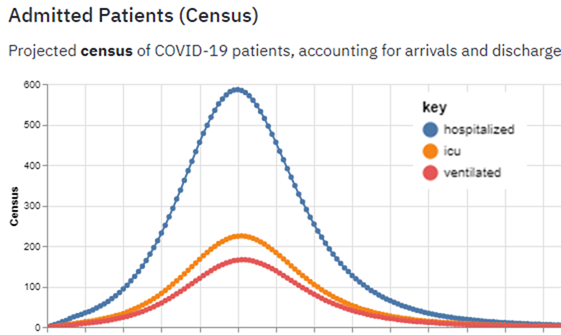COVID-19: How Many Beds Will You Need? And When?
Covid-19: A prediction challenge like no other
Covid-19 will challenge hospital leaders in many ways. But no one expected that a key challenge would be in a basic skill every hospital administrator mastered early in their career – estimating volume.
Hospital leaders are accustomed to estimating volume. They do it all the time – for a new physician or program, an enhanced service line, budgeting. Volume is predicted with a high degree of precision and sound decisions are built on those trustworthy volume estimates. But these are all linear estimates.
Then comes Covid-19, which requires an exponential growth model. Never before has predicting volume been so important, nor so difficult. Here’s why:
- Exponential growth magnifies the impact of assumptions, increasing potential error
- Social distancing efforts have been variable, so it’s difficult to predict their effectiveness in “flattening the curve”
- There’s limited firsthand experience caring for this population to accurately predict hospitalizations, ICU and ventilator use, and length of stay
- Delays in testing mean we don’t know who is infected in the general population and in hospitals
- Experts are offering several models, with widely varying volume estimates, ranging from scary to terrifying
Do you really need to figure out how many buckets of water are in that tsunami? How high the floodwaters will rise? There’s so much else to focus on, like obtaining PPE, managing finances, and leading a nervous workforce of frontline heroes.
The answer is yes, you need the most accurate volume predictions you can find for sound resource planning.
There are many models out there projecting bed, ICU, and ventilator need for the country, state or county, as well as the timing. But the predictions vary widely.
At first, models focused on the state or county level. The good news is there are now models that allow individual hospitals or health systems to estimate their own volume. However, these models have different methodologies, strengths and weaknesses, and are dependent on assumptions that are changing every day.
How can we tell which model is right?
Triangulating from multiple models is often better than relying on one. Governor Cuomo of New York references five models that they monitor.
As Veralon has assisted hospitals and health systems to predict Covid-19 volume, we have reviewed several models. Understanding each model’s methodology and the key assumptions that drive them determines their reliability for your hospital. Setting the right values for these assumptions is critical:
- How effective is the social distancing in our area?
- Are the default length of stay assumptions appropriate for my population?
- What about our capacity? We still have other non-Covid-19 patients to care for!
Operating as a single hospital or health system, it can be hard to evaluate model methodologies or know how to set key assumptions.
In this unprecedented time, Veralon is supporting our hospital and health system partners and offering this assistance at no cost. We maintain the confidentiality of each organization’s information, while helping each learn from the insights gained by others.
Source for chart: Penn Medicine Predictive Modeling https://penn-chime.phl.io/
Another hospital focused model is Qventus https://qventus.com/covid-19-model/
A state-by-state model is IHME https://covid19.healthdata.org/projections
Contact info@veralon.com to discuss how we can help.
